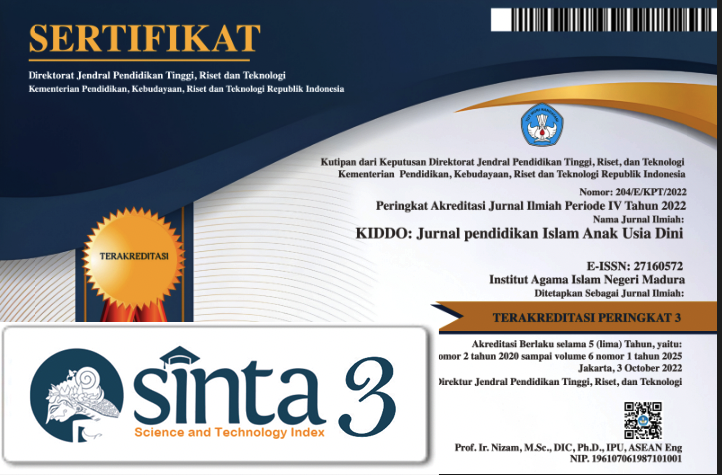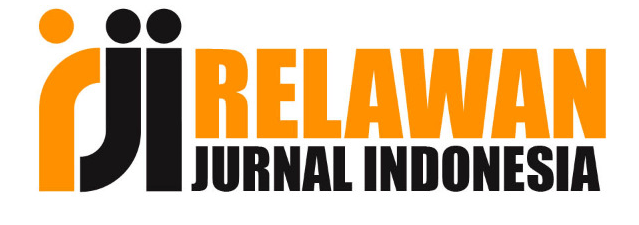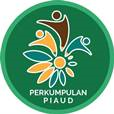Penerapan Pola Makan Bergizi untuk Kecerdasan Anak Usia Dini di PAUD Ramah Anak
 Abstract views: 132
,
Abstract views: 132
,
 PDF downloads: 156
PDF downloads: 156
Abstract
This study aims to determine the efforts of teachers in implementing nutritious food patterns that are beneficial for early childhood intelligence. The method in this study uses a qualitative descriptive approach. The research was conducted at the Cambodian Ponteh PAUD, Galis Pamekasan. Data collection techniques using observation, interviews, and documentation. The sources of informants in this study were the principal and teachers. Checking the validity of the data using triangulation techniques and sources. The results of the study show that: First, the application of a nutritious diet for children's intelligence is carried out twice a month on Fridays. The process begins with a discussion stage between the schools, then informs the students at the closing of learning, and also informs the student's guardians when it's time to go home from school. The results of implementing this nutritious diet have a positive impact on children's intelligence, such as language, musical, and kinesthetic intelligence. Second, the supporting factors in the implementation of this program are the full support of parents, the child's good mood, social, economic, knowledge, physical and mental, and good cooperation. While the inhibiting factors are the child's mood is not good, the child takes too long to chew food, the child does not like food provided from home, prefers friends' food, eats while chasing, fights to be fed by the same teacher, is too active in playing so the child does not want to follow the shared meal program, children's preferences and appetite. Third, the way the teacher overcomes obstacles that occur during the process of implementing a nutritious diet for children's intelligence, namely singing, telling stories, blending food if it is difficult to swallow, giving children appetite enhancing drugs, giving rewards in the form of children being allowed to go home early for those who manage to finish eating early, feed children by taking turns, form food with interesting creations according to children's preferences and if the child runs the teacher will tell the child to chase him back.
Downloads
References
Amelia, Vivi Leona. (2019) “Piring Makanku Sebagai Upaya Pembelajaran Porsi Makan Anak Bagi Ibu”, Fakultas Ilmu Kesehatan Universitas Muhammadiyah Purwokerto Artikel
Anggraeni, Dwiyani Dkk. (2019) “Implementasi Metode Bercerita dan harga diri dalam meningkatkan kemampua berbicara anak usia dini.” Jurnal Pendidikan Anak Usia Dini. Vol.3, No. 2 (Jakarta), 405.
Dahlia, Arum. (2011).
Habsari, Rian Putri dan Elisabeth Kristiana.(2013). “Studi Tentang Pelaksanaan Pemberian Reward dalam meningkatka Motivasi Belajar Kelompok A TK Islam Al-Azhar 35 Surabaya, Jurnal BK Unesa Vo.4 No. 1 (Surabaya), 280
Hasibuan, Rachma.(2018). Kesehatan dan Gizi Anak Usia Dini. Tangerang Selatan:Universitas Terbuka
Hasibuan, Tri Hartika Putri dkk. (2020) “Hubungan Pola Makan Dengan Status Gizi Pada Balita”, Universitas Prima Indonesia, Jurnal Kebidanan Kestra (JKK), Vol. 2, No. 2, April.
Kemendikbud, 2018. Penyiapan Lingkungan Belajar PAUD Ramah Anak Berkebutuhan khusus:BPPAUD dan Dikmas Kalimantan Selatan
Kurnia, Rita. (2019) “Bahasa Anak Usia Dini”. (Jogjakarta: CV Budi Utama), 3.
Kusumadila, K.S. (2021). Zat Gizi dan Anjuran Pola Makan. Guemedia
Nilawati Dkk. (2019) “Penerapan Metode Bernyanyi Untuk Meningkatkan daya ingat anak pada mata pelajaran SKI di Kelas 3 MI Karang ploso”. Jurnal Pendidikan Madrasah Ibtidaiyah, Vol. 1, No. 3 (Malang), 56.
Ni’mah, C. dan L. Muniroh.(2015). Hubungan Tingkat Pendidikan. Tingkat Pengetahuan dan Pola Asuh Ibu dengan Wasting dan Stunting pada Balita Keluarga Miskin. Media Gizi Indonesia.10(1).84-90
Proverawati, Atikah dan Erna Kusuma Wati. (2011) “Ilmu Gizi Untuk Keperawatan & Gizi Kesehatan”. (Yogyakarta: Nuha Medika), 76
Rahmawati, Afriyani. (2020). Analisis Pola Makan pada Anak Usia Sekolah. JKKP:Jurnal Kesejahteraan Keluarga dan Pendidikan. Vol 7, No. 1, 38-50.
Rianti Dkk. (2023). “Pengenalan Gizi seimbang Anak Malalui Kreasi bentuk makanan” Jurnal Ilmiah Perkembangan Anak Usia Dini. Vol. 2 No. 1, 81.
Riyadi, Hadi Dkk. (2011) “Faktor faktor yang mempengaruhi status gizi anak balita di kabupaten Timor Tengah Utara, Provinsi Nusa Tenggara Timur,” Jurnal Gizi dan Pangan Vol. 6, No. 1, 71.
Rusilanti, et.al. (2015) “Gizi dan Kesehatan Anak Prasekola”. (Bandung:PT Remaja Rosdakarya,), 132.
Setyowati, Heni Dkk. (2018) “Penyusunan media informasi tentang praktik pemberian makan untuk mencegah stunting pada anak balita”. Indonesia n Journal of midwifery (IJM). Vol. 1 No. 2, 114.
Sitoayu, Laras Dkk. (2020).“Makan Bergizi Dan Hidup Penuh Prestasi, Fakultas Ilmu Kesehatan, Universitas Esa Unggul, Jakarta Jalan Arjuna Utara, Tol Tomang, Kebun Jeruk Jakarta”. Jurnal Abdimas, Vol. 6, No. 2, Januari.
Susanti, Endang dan Nur Kholisokh. (2018).“Konstruksi Makna Kualitas Hidup Sehat”. (Studi Fenomena Komunitas Herbalife Klub Sehat Ersanddi Jakarta), Universitas Marcu Buwana Institut Ilmu Sosial dan Manajemen STIAMI, Jurnal Lugas, Vol. 2, No, 1, Juni,
Wahyuningsih Eko Sri. (2022) “inovasi tanaman jamu pembuatan eskrim temulawak sebagai peningkat nafsu makan” jurnal pengabdian masyarakat. Vol. 2 No. 3, 6
Copyright (c) 2024 Yayik Indah Susnita, Selfi Lailiyatul Iftitah

This work is licensed under a Creative Commons Attribution 4.0 International License.
-
The journal operates an Open Access policy under a Creative Commons 4.0 International license. The terms of the license are:
Share— copy and redistribute the material in any medium or format
Adapt— remix, transform, and build upon the material for any purpose, even commercially.
1. Authors retain copyright and grant the journal right of first publication with the work simultaneously licensed under a Creative Commons License.that allows others to share the work with an acknowledgement of the work’s authorship and initial publication in this journal
2. Authors are permitted and encouraged to post their work online (e.g., in institutional repositories or on their website) prior to and during the submission process, as it can lead to productive exchanges, as well as earlier and greater citation of published work (See The Effect of Open Access).
Jurnal Kiddo is licensed under a Creative Commons
n Access).














